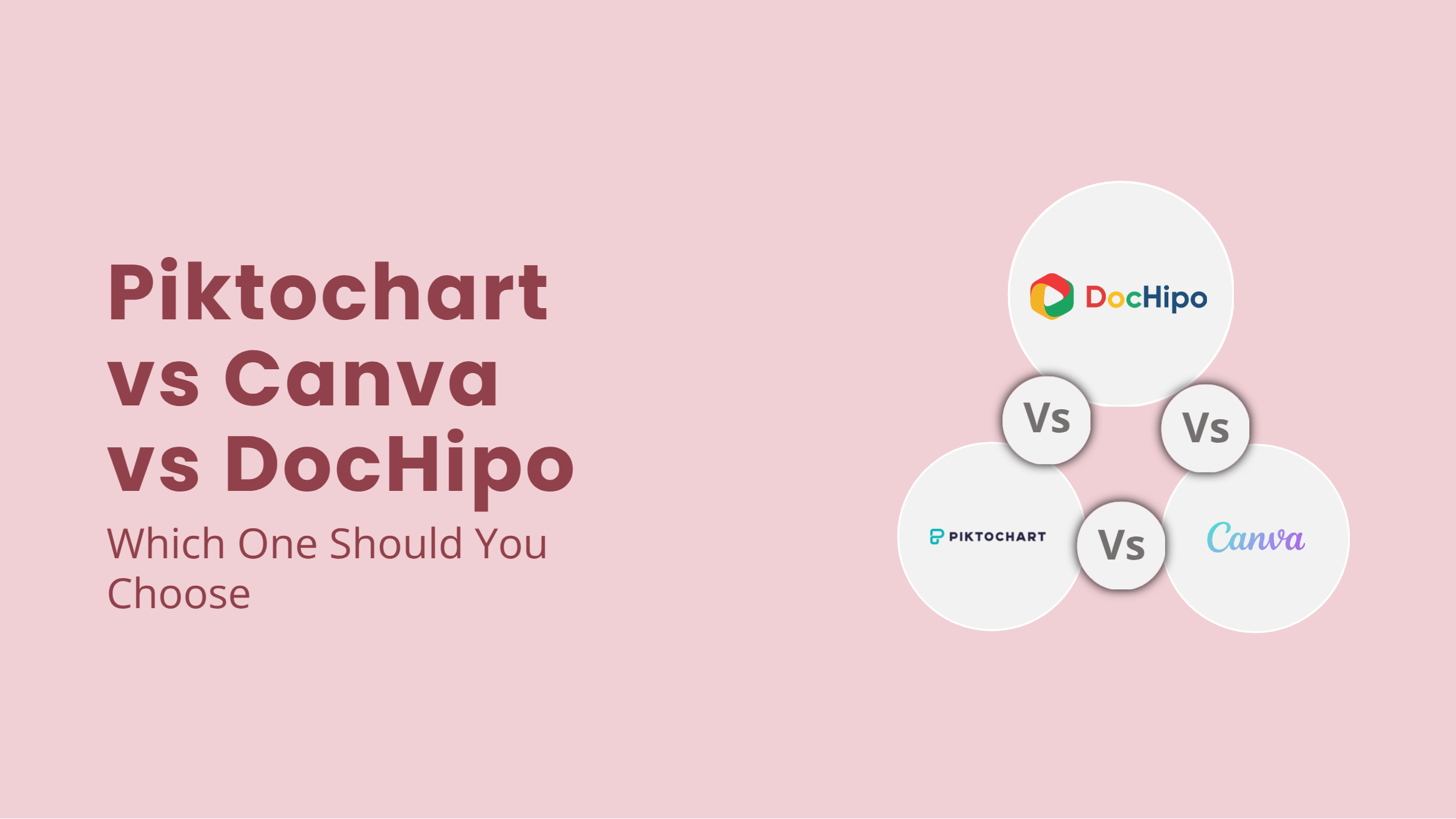
Piktochart vs Canva vs DocHipo: Which One Should You Choose

Whether you’re a marketer, small business owner, educator, or content creator, choosing the right design tool is essential to bring your ideas to life without the steep learning curve of professional software.
Among the popular options, Piktochart and Canva fulfill various purposes. However, we would like to introduce another ever-expanding design tool – DocHipo. To provide a well-rounded perspective, here is a comparative review of Piktochart vs Canva vs DocHipo.
Piktochart vs Canva vs DocHipo
- Piktochart: If you are looking for a tool to create professional designs with complex data visualizations. It is suitable for educators, marketers, and professionals.
- Canva: If you are looking for a versatile design tool that helps you create and schedule posts. It is most suitable for businesses, freelancers, and creators.
- DocHipo: If you want a clutter-free and budget-friendly design tool that helps you or your team create on-brand designs. It is ideal for solopreneurs, businesses, startups, and marketers.
In this blog post, we’ll dive deep into a feature-by-feature comparison of these three tools, including the user experience, templates, design assets, features, and pricing. This guide will help you decide which one truly aligns with your creative goals and workflow.
Table of Contents
- What is Piktochart
- What is Canva
- What is DocHipo
- Interface: User friendliness and Accessibility
- Templates – Quality, Category, and Aesthetics
- Design Assets: Piktochart vs Canva vs DocHipo
- Data Visualization: Canva vs Piktochart vs DocHipo
- Core Design Features: Basic and Advanced Capabilities
- Sharing and Collaboration for Teams and Various Platforms
- AI Tools: Canva vs Piktochart vs DocHipo
- Video Editor: Piktochart vs Canva vs DocHipo
- Proposal Maker: Features and Usability
- Apps and Integrations for Seamless Workflow
- Pricing: Piktochart vs Canva vs DocHipo
- Suitability for Designs and Users: Piktochart vs Canva vs DocHipo
- FAQs
What is Piktochart
Piktochart is an online graphic design tool designed for professionals. It offers a range of templates and design assets. As one of the Canva alternatives, the tool provides a range of design assets for visually appealing data visualization, which is essential in everyday business communications. Piktochart stands out with its AI design generator, enabling the creation of multiple documents.
What is Canva
Canva is an all-in-one design tool for everything from design creation to scheduling and brand management. It has already established itself as a benchmark in graphic design tools, offering a wide array of features to let your creativity flourish. The tool also offers advanced generative AI capabilities, enabling you to create images, text, and designs using prompts easily.
What is DocHipo
DocHipo is an ever-evolving document creation tool for all branding and marketing needs. This robust yet minimalist tool is easy to use, featuring eye-catching templates and advanced AI capabilities. DocHipo proves to be an excellent alternative to Piktochart for users who require designs tailored specifically to their business needs.
This was just a brief introduction to the three tools. Let’s dive deeper into the nitty-gritty of features and compare Piktochart vs Canva vs DocHipo.
Interface: User friendliness and Accessibility
As we evaluated the three tools, we were able to differentiate between the ease of use and learning curve for each of them. All three tools offer design templates and enable drag-and-drop functionality for a smooth design experience. However, they have their highs and lows at different levels; let’s discover them one by one.
Piktochart
As soon as we land on the Piktochart website, the tool highlights its ‘next generation of infographics’. After signing up, you are presented with a clean and organized dashboard.
The Dashboard has everything you need, from AI tools and templates to saved projects, brand kits, and a video maker. Since everything is within your cursor’s reach, it gives a clean and organized feel. However, editing the designs is not as smooth as with other design tools, as the tool occasionally lags.
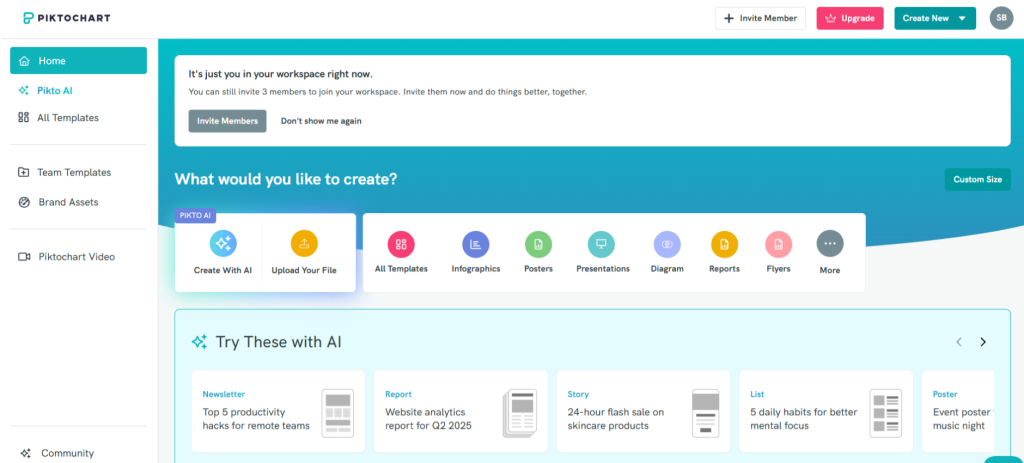
In Piktochart’s editor, the lack of categorization consumes time and lengthens the learning curve. Additionally, the search filters for templates require some improvements, as they do not provide focused results for specific industries and themes. It also affects the ease of accessibility for assets and features while customizing the designs.
Canva
In comparison to Piktochart, Canva’s interface is quite vibrant and full of creative energy. However, if you’re a fan of clean aesthetics, the tool may seem clunky. Additionally, the vast number of templates and capabilities it offers may overwhelm you if you are looking for quick design solutions.
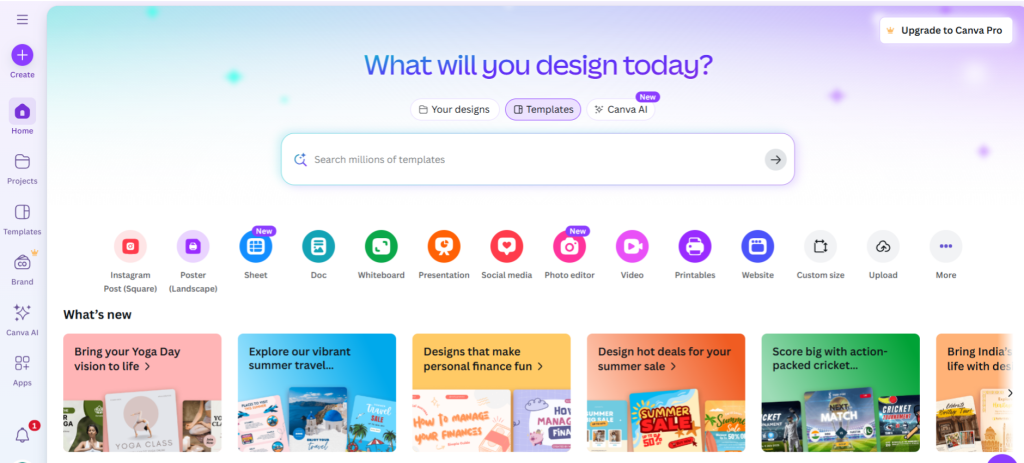
Since the tool has many features, you may need some time to become familiar with all of them. Additionally, as a free user, navigating through templates and design assets can be time-consuming due to the large number of premium designs.
DocHipo
Among Canva vs Piktochart vs DocHipo, DocHipo stands out with its clutter-free interface and minimal learning curve. First, the homepage is distraction-free without unnecessary ads or noise. Next, after signing up, you will land on the All Templates page, which features ample white space to breathe.
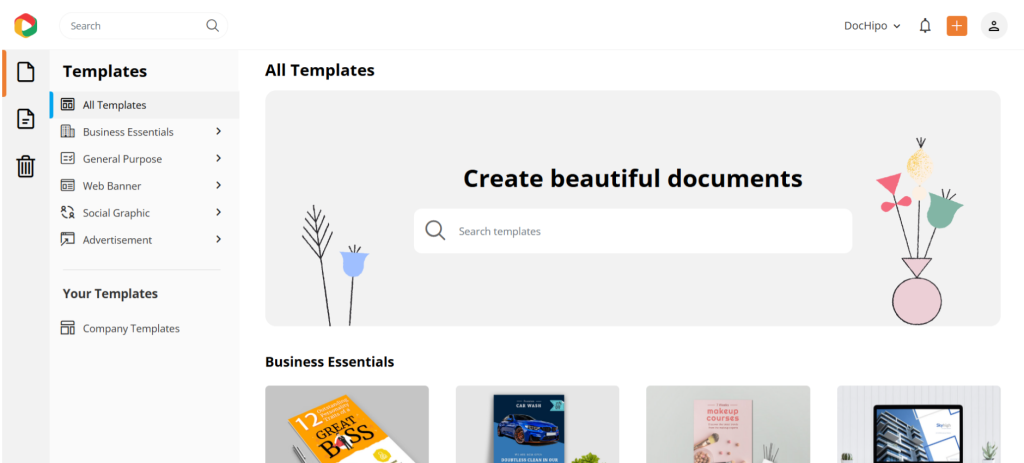
We appreciate the well-organized categorization at every step, whether it’s templates or asset features. It keeps designing simple and helps with quick designing too.
Templates – Quality, Category, and Aesthetics
All three tools offer numerous templates for printables and online platforms. Nonetheless, they differ in quantity, quality, and design aesthetics.
Piktochart
Piktochart offers a variety of templates for infographics, reports, presentations, posters, flyers, timelines, planners, invoices, social media posts, banners, and more. Additionally, most templates focus on festive occasions and personal use, including planners, lists, and wallpapers.
However, the designs could have been better aligned with various business purposes like sales, advertising, opening, discount offers, etc.
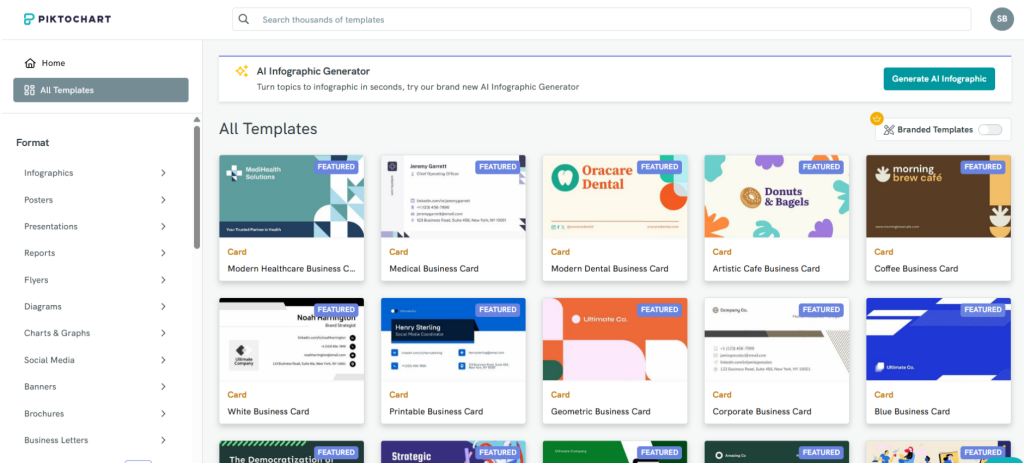
Next, upon noticing the designs, we found that they cater to professionals in education, research, healthcare, and business communications. Piktochart’s templates shine with built-in charts, icons, and data widgets.
The template designs are more inclined towards clean and sorted designs. However, Piktochart can certainly introduce enhanced designs with depth and eye-catching designs that spark interest for the viewers.
Overall, the templates stand out if you work with complex data and want to replace the monotony with engaging data visualizations. The templates can simplify your everyday business communications, planning, and execution.
Canva
When compared to Piktochart, Canva offers a vast array of templates for every use case. Whether it’s a whiteboard, presentation, social media, website, printable, or mockup, you can find a suitable template here. You can obtain static and video templates for most formats.
Once you have searched for the document type, you can further refine your template by filtering it based on color, style, theme, industry, and other criteria.
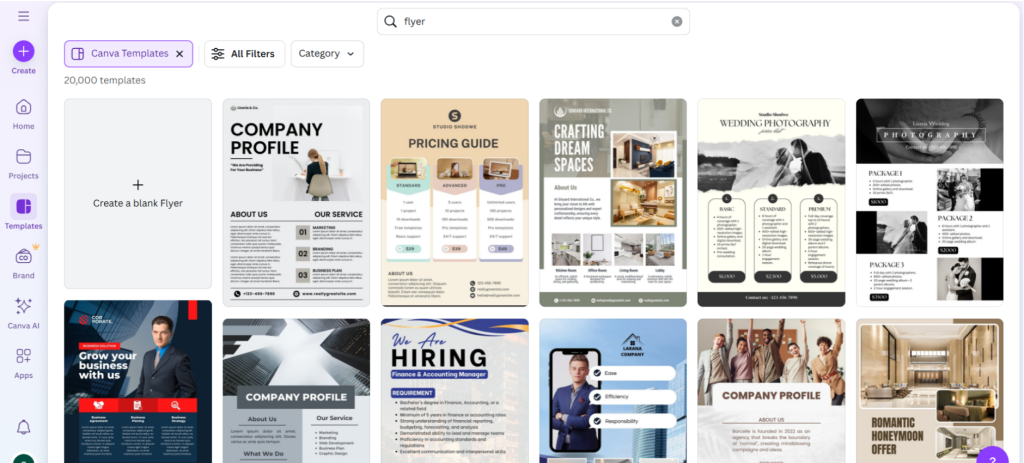
The template designs feature top-notch quality with high-resolution graphics and a variety of aesthetics to suit your taste. As a free user, the premium templates have slightly superior design aesthetics than the free ones.
Also, due to Canva’s popularity, it is challenging to stand out with the free designs. Another issue that can bother you is the presence of a watermark with some design elements in the template. Either you need to remove the element or replace it with another asset that could consume your time.
DocHipo
After Canva vs Piktochart, let’s explore DocHipo templates. The tool offers premium design templates, whether you are using the free template or the paid ones. You can get a variety of templates for business purposes, printables, case studies, presentations, menus, web banners, social media posts, advertisements, and more.
Unlike Piktochart, DocHipo also includes LinkedIn Carousel, Pinterest graphics, and WhatsApp status, among others. What we love is the well-categorized templates for different themes, occasions, formats, and industries.
Plus, you can explore free and premium templates separately to save your time. Whatever you use, every layout is a professionally curated masterpiece, designed to fulfill your business needs.
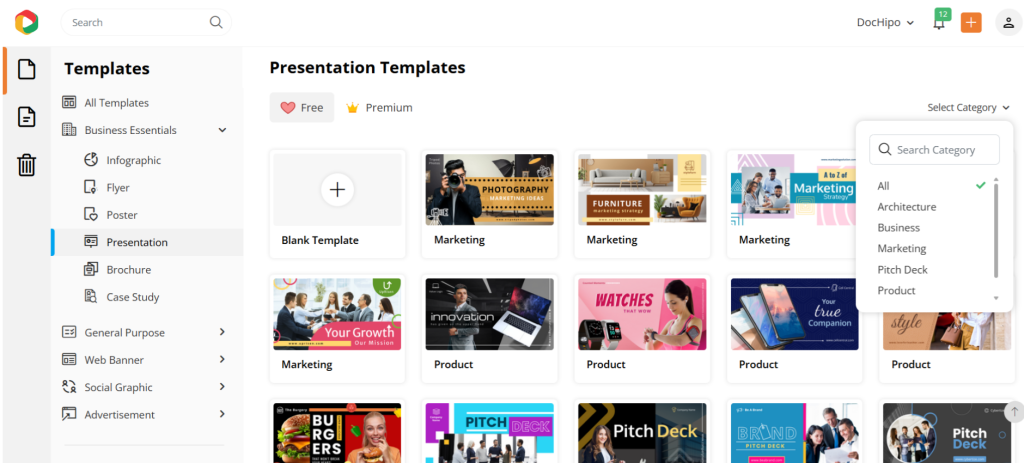
When we compare the designs, they overpower the Piktochart templates in terms of attention-grabbing designs with a lot of depth through elements. Unlike Canva, you won’t face any watermark issues when using it. Overall, DocHipo is your go-to tool for quick design solutions to meet everyday business needs.
Design Assets: Piktochart vs Canva vs DocHipo
Let’s explore the design assets of each tool, what they have in common, and how they differ from one another.
Piktochart
Piktochart includes a wide range of design assets, including shapes, backgrounds, icons, illustrations, and stock images. However, you can find many different types of assets under icons like isometric, lines, colored outline, glyph, gradient, rounded, sticker, and pixel.
To access any asset, you can search for it in the ‘Illustrations’. As a first-time user, the lack of proper categorization can seem confusing. Plus, you can bring color customizations to limited assets. Another interesting design asset is the 3D illustrations that give your designs an edge. However, the tool can also add a few animations for designing purposes.
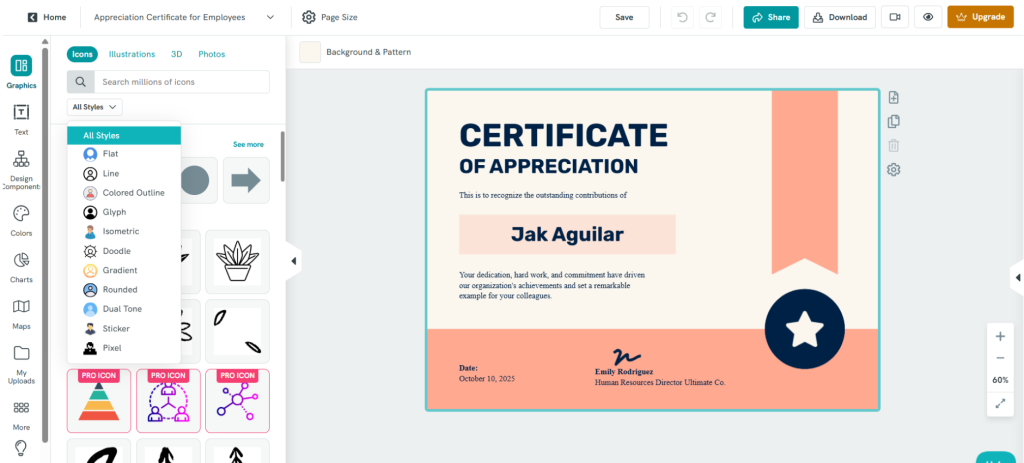
Another interesting option is the Design Component. It contains creative assets, including text banners, flowcharts, graphics, and text combinations, as well as processes. Furthermore, you can customize every aspect of design elements, unlike Illustrations.
You can find a variety of background patterns and colors, but the tool does not offer gradient colors for any of the assets. Additionally, the tool provides a range of design components, including masked photos, graphics, text combinations, preset text styles, data, and metric visualizations.
Piktochart’s strength lies in the details of data visualization assets. You can use various types of visuals, such as bar graphs, Venn diagrams, pie charts, bubble charts, donut charts, and maps. Furthermore, you can easily customize the visualization by adjusting its size, orientation, color, and adding text, among other options.
Canva
Like Piktochart, Canva also offers plenty of design assets within the editor under the ‘Elements’ section. You can find a variety of elements, including lines, shapes, backgrounds, vector graphics, animations, polls, charts, collage grids, mock-ups, and more.
Along with these, you can also explore various preset font combinations in exquisite typography. To find any graphic asset, you can search for it, and you will have numerous assets. However, without a paid plan, you need to go through a lot of them to see what is accessible.
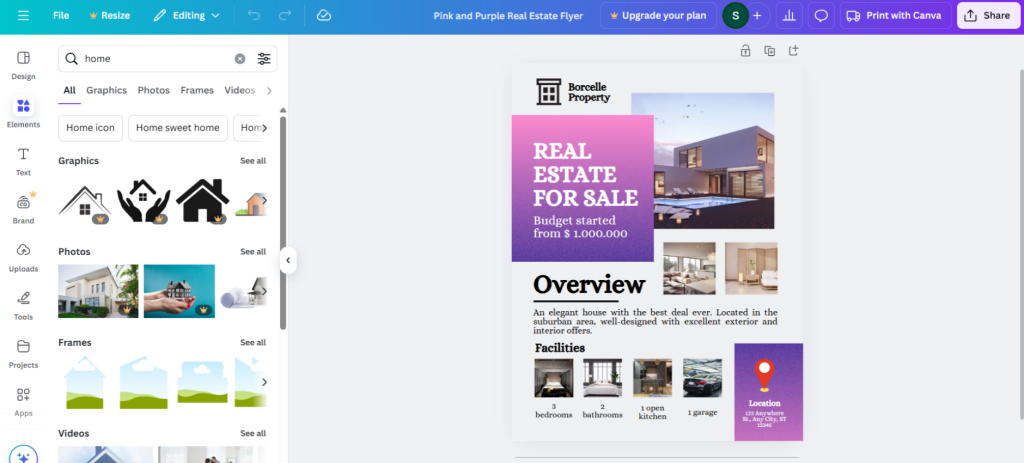
Another interesting category is ‘Collections’, where you can find on-theme illustrations for various art styles, occupations, cultures, and occasions.
Customizing each of these assets is a breeze, as you can easily manipulate the size, orientation, and color. You can also enhance pictures with advanced photo editing options powered by AI. Additionally, you can find stock videos and audio files to add dynamic effects to your designs.
DocHipo
Like Piktochart and Canva, DocHipo also offers rich design widgets, but in a more organized manner. As soon as you land in the DocHipo editor, you will notice every asset categorized as a design widget, including background, line, shapes, stickers, icons, illustrations, stock images, text frames, videos, animations, etc.

For shapes, DocHipo offers a wide variety, unlike Piktochart, which only provides basic ones. You can find shapes ranging from geometric to abstract, trendy, and ornamental. Additionally, you can customize the size, orientation, and color, choosing between solid or gradient hues.
For backgrounds, you can choose from solids, gradients, patterns, and beautiful floral designs. While searching for vector graphics, you can choose from a well-categorized menu or search according to your preference. You can get suitable graphics for a variety of themes, objects, lifestyles, cultures, countries, industries, and more.
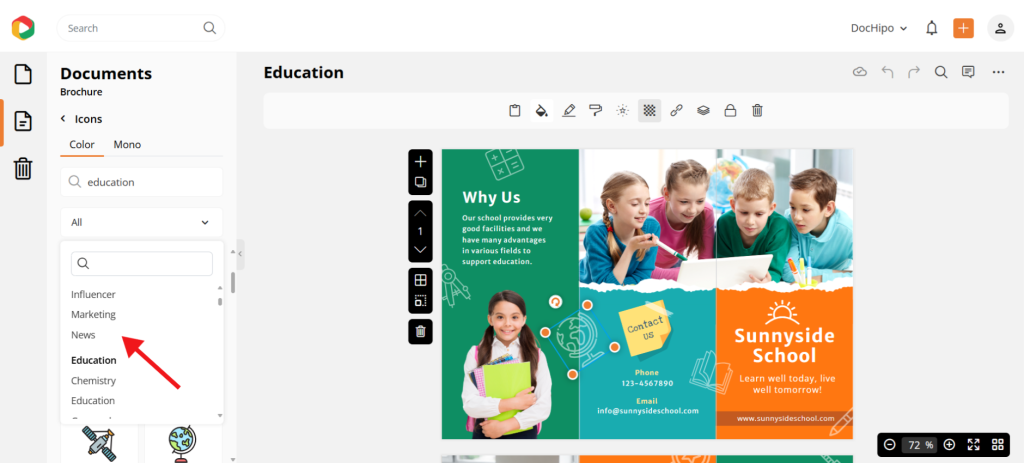
What caught our attention was the library of colorful icons that contain their monochrome counterparts, allowing them to blend seamlessly with designs. Additionally, there are two types of illustrations: Solo and Scene. While Solo illustrations are minimal, Scene illustrations depict a visual story.
Data Visualization: Canva vs Piktochart vs DocHipo
While comparing Piktochart with other tools, we also took note of data visualization capabilities. So, let’s find out what options are available and how you can use them for your designs.
Piktochart
Piktochart’s strength lies in the details of data visualization assets. You can use various types of visuals, such as bar graphs, Venn diagrams, pie charts, bubble charts, donut charts, and maps. Furthermore, you can easily customize the visualization by adjusting its size, orientation, color, and adding text, among other options.
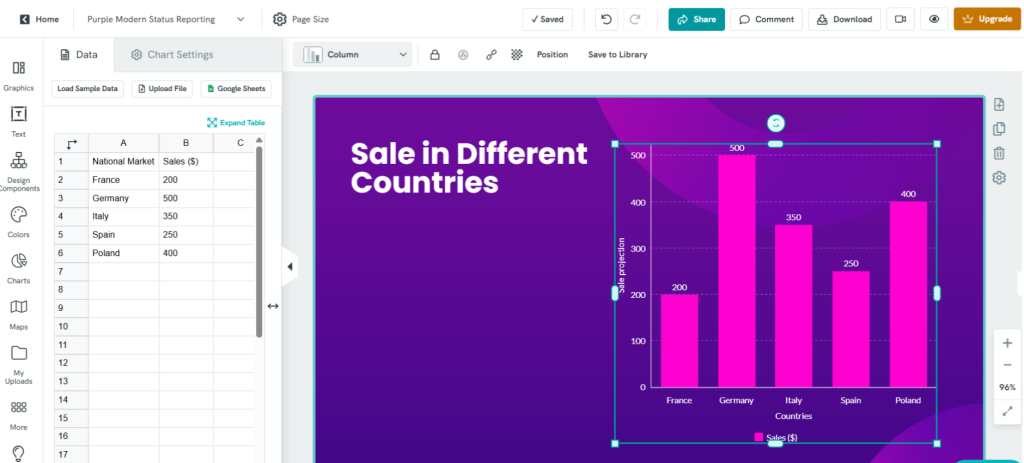
Additionally, the chart settings offer flexibility to customize legends, axis titles and labels, fonts, data formats, colors, etc. The tool also allows you to upload sample data and Google Sheets to turn them into eye-catching visualizations.
Piktochart also offers interactive maps for numerous regions and countries. Here, you can customize the data, color scheme, legends, placement of legends, etc.
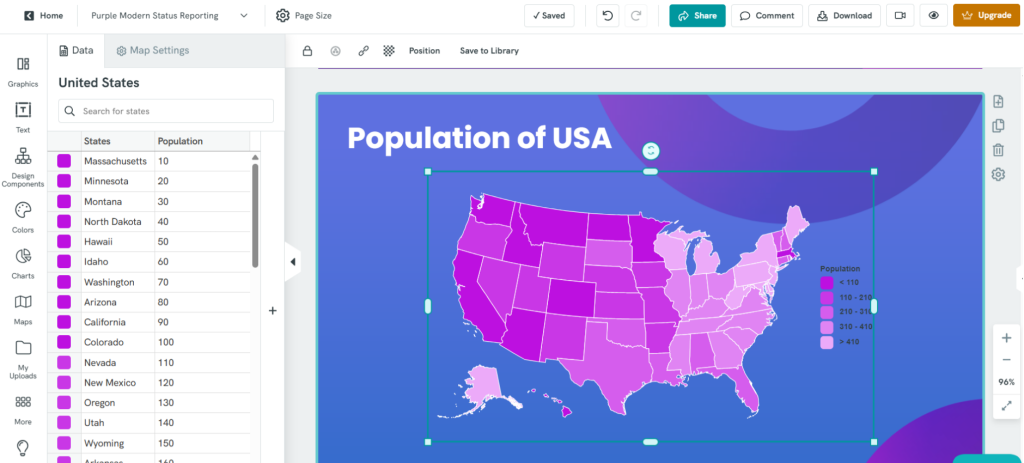
Canva
Canva includes Charts within the Elements section in the editor. You can find several visualizations such as bar charts, line charts, pie charts, area charts, hierarchy charts, infographics, and more. In addition, you can create your chart styles and save them in the brand kit.
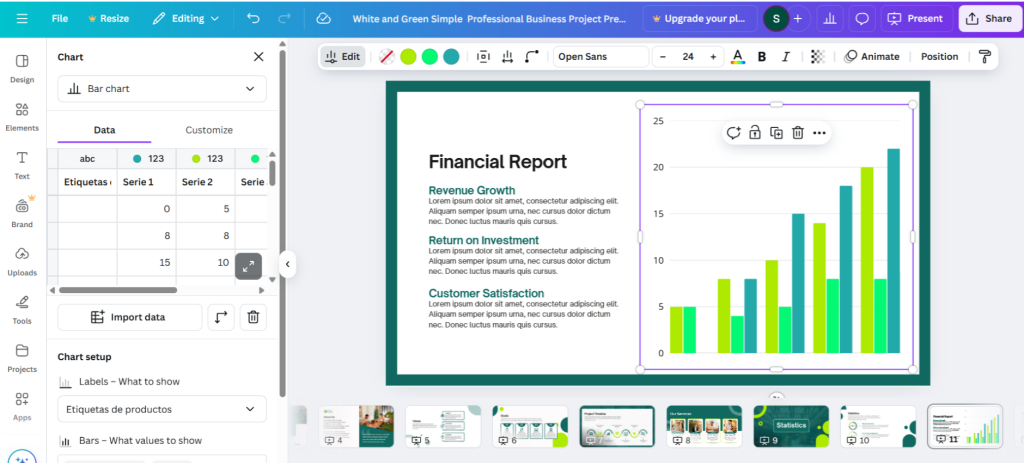
Another interesting feature is that you can swap rows and columns with just a click for data visuals.
You can easily customize the data, labels, and other information, including the aggregate data. Like Piktochart, you can customize legends and axes. Plus, Canva offers other enhancements like padding and spacing between the columns. However, you might find too many customization features overwhelming.
Unlike Piktochart, Canva does not offer maps for data visualization.
DocHipo
DocHipo also offers charts and maps for data visualization. With Charts, you can use plenty of options like vertical bar, pie chart, line, area, and more.
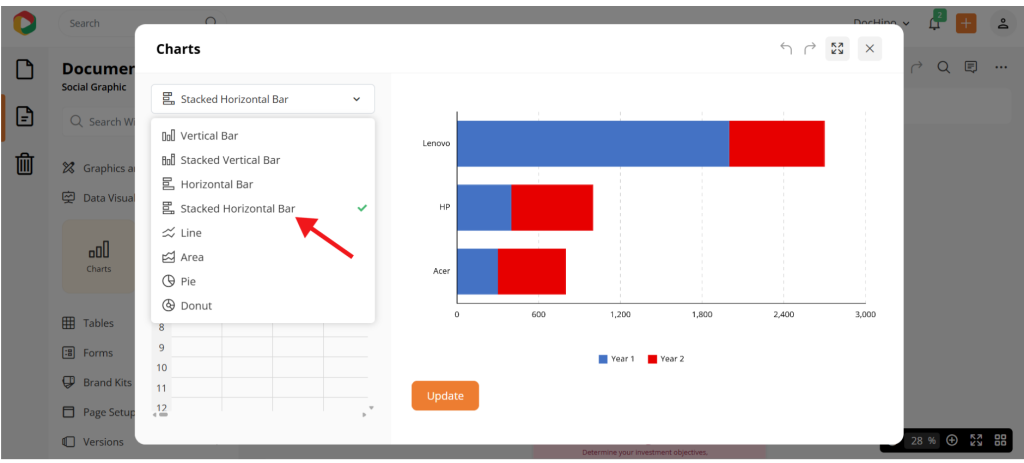
You can easily customize them as the visuals adjust automatically as per the inserted data. Furthermore, you can pick suitable colors, even brand colors, that align with your overall design. Like Canva, DocHipo also offers the single-click Swap option to swap rows and columns for charts.
Within the Settings option, you can label the X-Y axis with additional information, change fonts, and customize grid colors. DocHipo also helps you to modify little details like the visibility of grid lines, labels, captions, and legends.
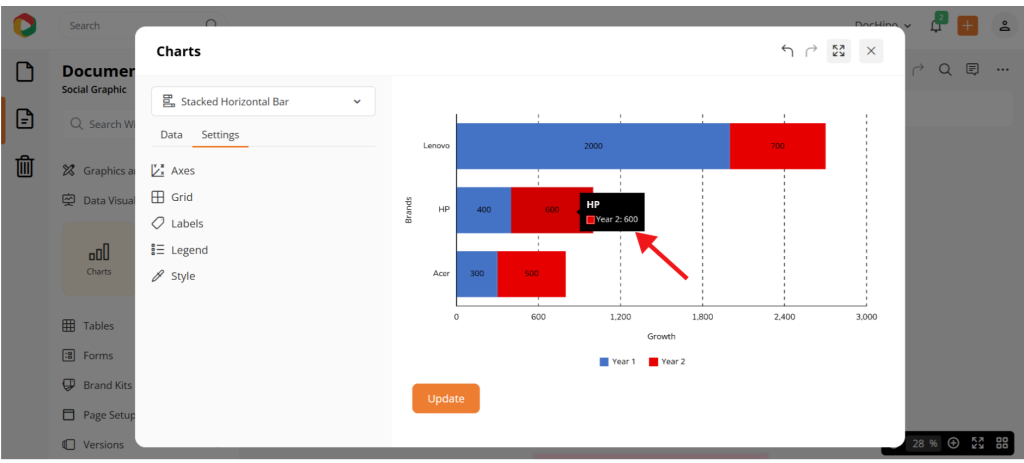
Like Piktochart, DocHipo also offers interactive maps for data visualization with similar customization capabilities.
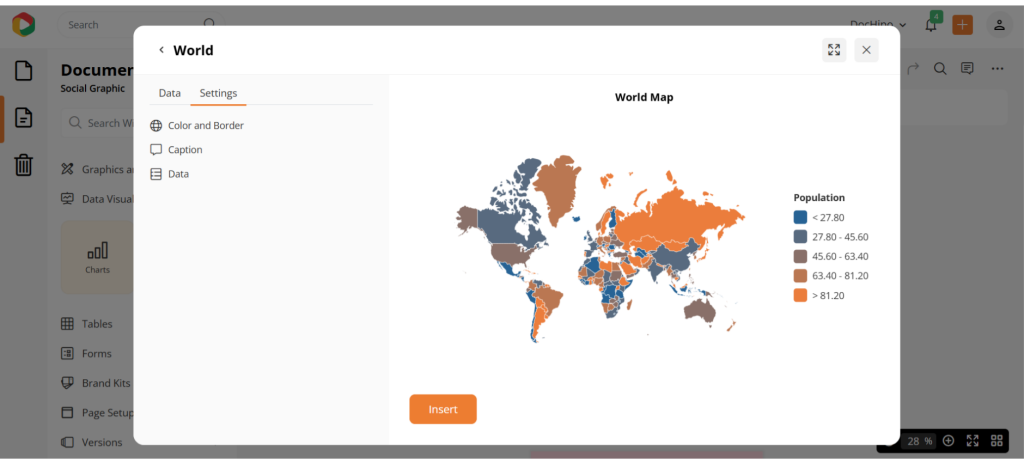
Core Design Features: Basic and Advanced Capabilities
Now that we are familiar with templates and design assets, let’s examine the core design features of Piktochart vs Canva vs DocHipo. All three tools are similar, as you can easily customize all the design elements within the templates, customize and resize designs, and save assets with the brand kit. However, some capabilities distinguish one from the other.
Piktochart
Piktochart offers basic customization capabilities within its editor. However, the tool stands out in converting documents, including CSV and XLSX files, into engaging data visuals. Users can pull data from spreadsheets or input it directly into the chart builder using various visualization styles.
Afterwards, you can customize the text, color, display, positioning, and other settings with the Chart settings. You can also change the color palette using the preset Color Schemes. Nonetheless, the tool can offer more options with various color combinations.
You can also change the background color with custom colors and brand colors. However, when we scrolled the option for further patterns, not all the possibilities were visible for easy access. Additionally, there are limited text customization options, which are limited to color, size, and fonts, while the ability to add shadows and outlines is missing.
Within the editor, once you have selected a template from the existing library, you cannot access generative AI tools. Users may feel restricted to using AI features only within the editor. Additionally, the tool offers limited download options, including PNG, PDF, and PowerPoint, but does not allow most of these in the free plan.
With Brand Kit and Team Templates, you can save essential assets, such as fonts, logos, colors, and graphics.
Canva
Once you have selected a template and proceed to the editor, you can select from similar templates and styles. For text customization, you can easily change the font, colors, and add creative effects too.
Canva also offers preset font combinations for different themes and moods. The tool provides a vast number of assets; however, you need to find the one that you can access if you are using the free plan.
Within the Styles, you can choose from different color palettes, aesthetics, and font styles. The best part is that you can simultaneously change everything with just a click.
In addition, you can animate any design element, be it text or graphics. Additionally, you can enhance pictures with selective editing, special effects, and photo filters. Specifically, impacts like Auto Focus and Face Retouch are handy for editing images for social media.
Canva also offers video editing in layers, allowing you to add basic customization options, such as cropping, adjusting speed, and modifying tonal quality. Unlike Piktochart, Canva does not have any transcribing features.
Within the Brand Kit, you can save a variety of assets, including fonts, colors, charts, graphics, logos, and the brand voice. You can also save brand templates to maintain brand consistency with ready-to-use layouts.
DocHipo
Like Piktochart and Canva, DocHipo also offers a wide range of design features. It provides basic customization capabilities along with advanced AI features, everything in one place for easy access. Designing with this tool feels less clunky without compromising your creative freedom.
While experimenting with colors, we discovered several customization options, including solid, gradient, and transparent color effects that you can apply to text and shapes. You can give a creative edge to the text with transparent colors, bringing in outline borders through text styles. Additionally, you can also apply effects like shadow, border, and outline to the text.
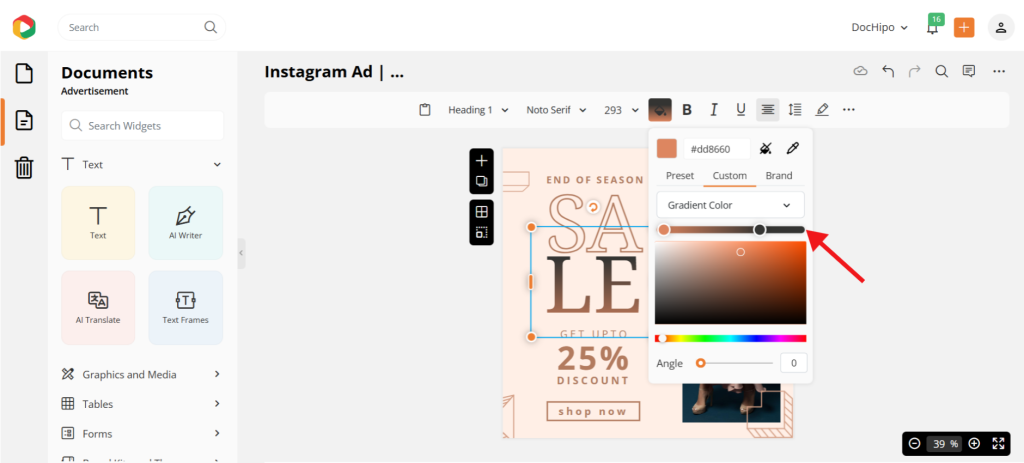
Furthermore, you can personalize texts with Custom fonts as well. Other features, like Copy style, come in handy, which helps align every element with each other in the layout.
Moreover, the tool also offers a built-in collage maker, QR code generator, and a greater range of options for customizing Tables. DocHipo also offers Photo Filters to enhance images and basic video trimming capabilities within the editor.
Within the Brand Kit , you can save logos, color palette, fonts, images, and videos. With Company Templates, you can save your signature designs and control access to all the assets, too. Unlike Piktochart and Canva, you get a well-categorized Color Themes feature with color combinations for every shade, mood, nature, occasion, style, and weather.
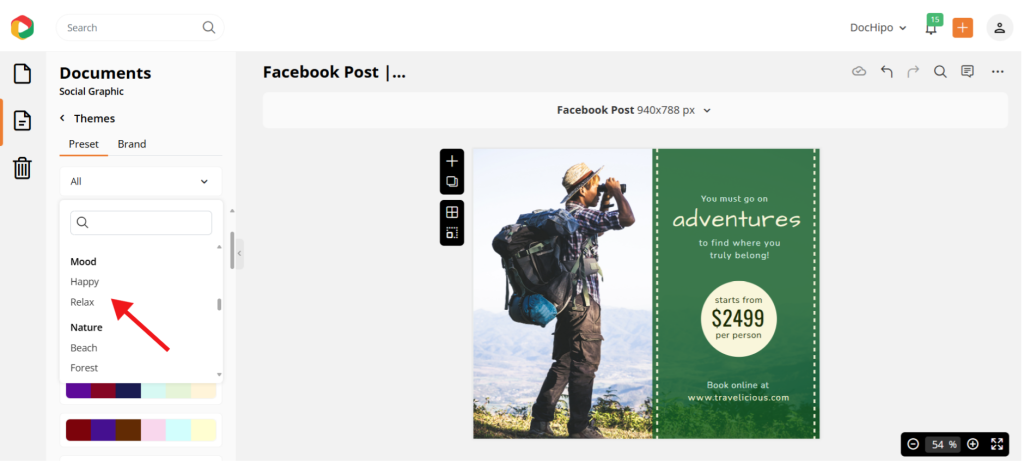
Sharing and Collaboration for Teams and Various Platforms
When comparing Piktochart vs Canva vs DocHipo, all three offer similar collaborative and sharing capabilities. The tools enable real-time design collaboration, allowing multiple team members to design and share their inputs. With Piktochart, you can select specific areas on the canvas and leave comments for others, whereas in DocHipo, you can interact with an integrated chatbox.
Furthermore, you can share the document via a link and email. With Canva, you can easily generate a QR code for your document to facilitate smooth sharing. Plus, publishing documents to various social media platforms is easy. DocHipo allows you to set a password when publishing, and you can also enable viewers to download the published documents.
AI Tools: Canva vs Piktochart vs DocHipo
All three tools offer AI capabilities, with some being more advanced than others. Let’s explore each of these.
Piktochart
You can access all the AI capabilities of Piktochart under the Pikto AI option only. Here, you can use an AI-powered visual generator to create any document type, like an infographic, print, social media, presentations, etc.
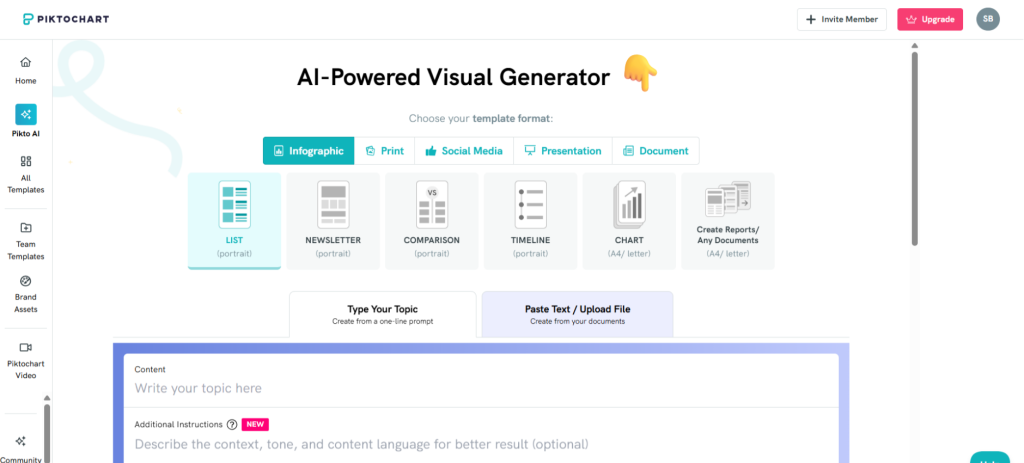
All you need to do is describe the content type and the theme of the design. In addition, you can upload an existing document and create a design in a particular format. However, the tool does not allow you to create standalone pictures and text copy within the designs. Additionally, basic features such as a background remover are also absent.
Canva
When comparing Canva vs Piktochart, Canva offers significantly more AI capabilities. With Canva AI, you can generate images, videos, blog posts, and even create code. Canva’s AI is considerably more advanced, as it allows you to personalize results and create seamless workflows.
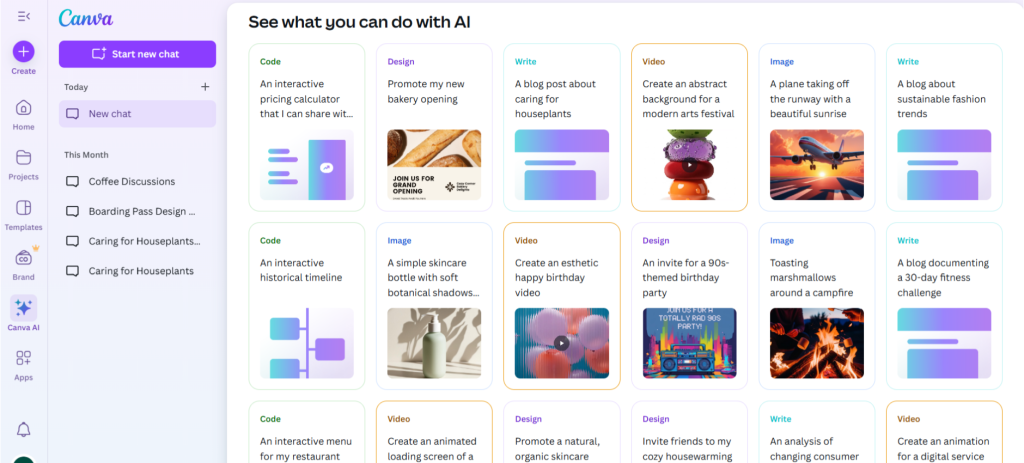
The Magic Studio provides a range of features to enhance your photos. You can remove or replace the background, erase objects, expand, and edit pictures with simple prompts. With features like Magic Grab, you can selectively edit objects within the images. Moreover, Magic Write helps you to create error-free text content in suitable tones.
DocHipo
DocHipo also offers AI capabilities that integrate well with the design workflow. If Piktochart feels restrictive and Canva’s AI feels overwhelming, consider DocHipo’s AI features, which also allow you to generate images and text.
With the AI image generator, you can create AI Images with a text prompt in various styles, including 3D, anime, illustration, logo, oil painting, watercolor, cinematic, and realistic. Once you have created an image, you can also switch between the styles. Also, you can remove the background of any picture with just a click for a polished look.
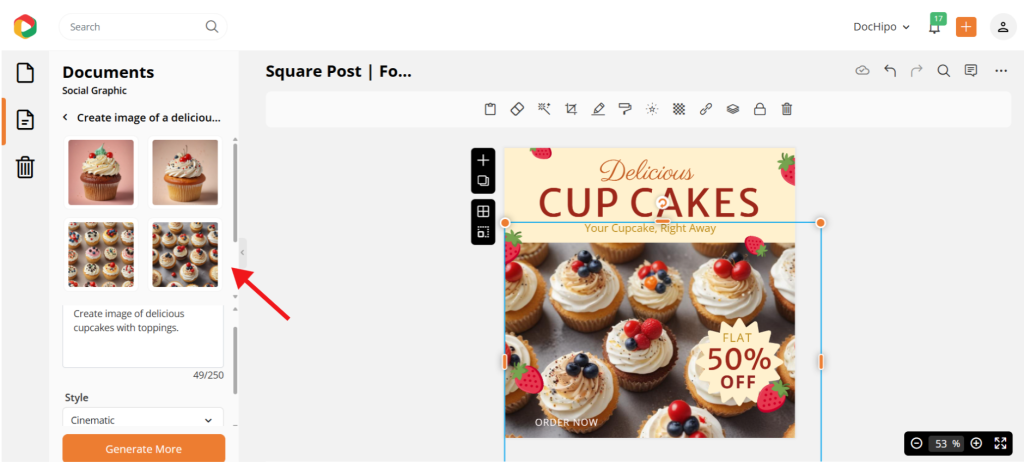
Next, you can generate text for taglines, ideas, headlines, product descriptions, and long-form content with AI Writer. You can also choose the tone of the text from casual, professional, friendly, funny, confident, etc. Furthermore, you can repurpose designs in 100+ languages with AI Translate.
Video Editor: Piktochart vs Canva vs DocHipo
Piktochart, Canva, and DocHipo offer beginner-friendly video makers. However, their editors and features vary; thus, we will explore each to help you decide which suits you best.
Piktochart
Piktochart’s video editor helps you to edit, transcribe, and repurpose them for social media. Although there are limited video templates, you can upload or add a screen recording and a cam recording, then start editing.
The editing capabilities are unique, as you can edit the video like editing text. To do this, you can cut videos into shorter clips by highlighting parts of the transcript. Next, easily remove unwanted parts, add intros/outros, and you are ready with the edited video.
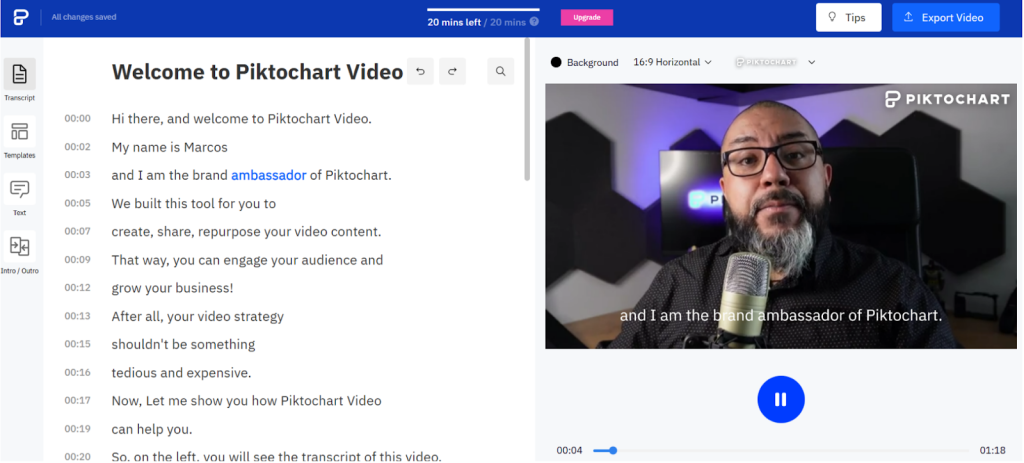
On top of that, you can automatically add captions in over 60 languages and edit the text style. However, you might not be able to add animations and adjust the timelines for various graphics and text.
Users accustomed to layered video editing may need some time to adapt to Piktochart’s features. They may also experience occasional lag while editing videos.
Canva
Canva’s video editor helps you create social media videos. You can start with video templates available for all types of post formats and platforms. Next, you can edit these templates in the multilayered video editor.
Canva also offers some advanced editing features while you customize your video. You can remove the video background, add captions, record voice, and adjust the timelines of various objects within the video.
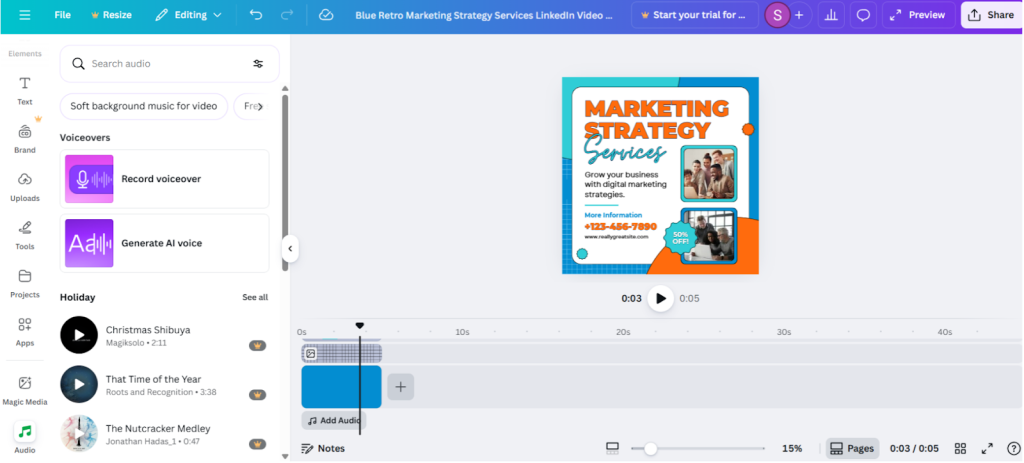
In addition to these, Canva also helps you highlight the best clips of your video. With Magic Video, you can upload clips and edit them with a prompt. You can take a back seat as the tool gives a polished outcome, ready for upload.
DocHipo
DocHipo offers an intuitive, easy-to-use Video Maker with a negligible learning curve. Get started with professional Square Video Templates with intros, middles, and outros. Here, you can get templates for travel, weddings, and festive occasions that align with the business needs.
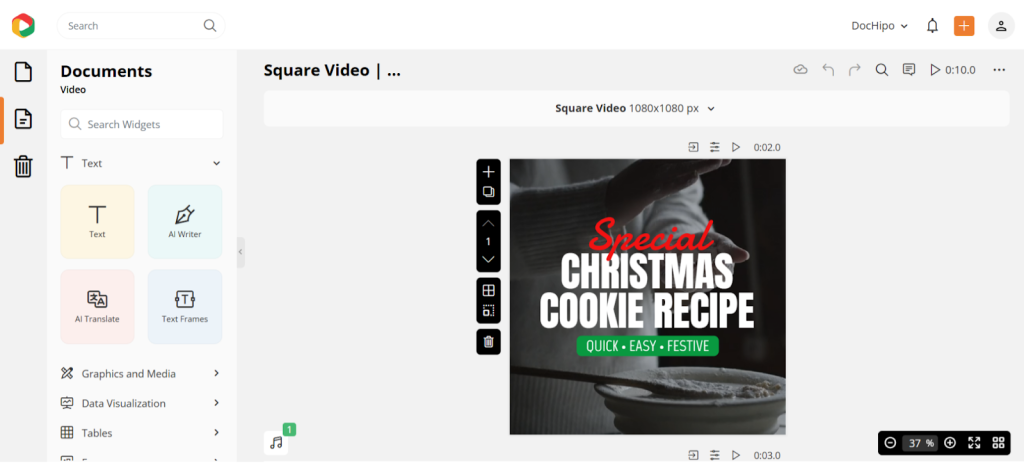
In addition, you can upload or select a stock video, crop it to shape, enable loop, and add filters to align with the overall layout. Unlike Piktochart, DocHipo offers layered editing that lets you animate design elements and adjust their speed.
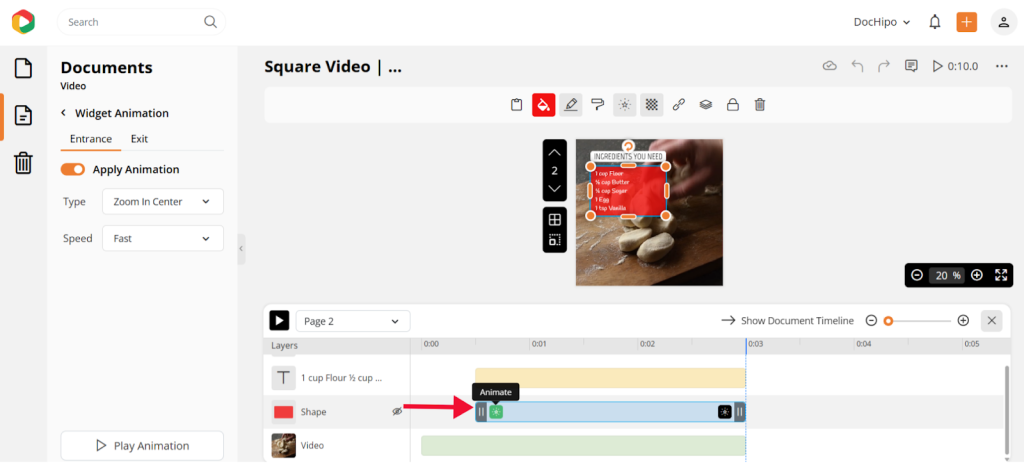
Unlike Canva’s editor, DocHipo’s editor is organized, offering a separate editor where you can adjust the timelines of the scenes and the entire document. Here, you can also add audio clips and adjust the fading effect.
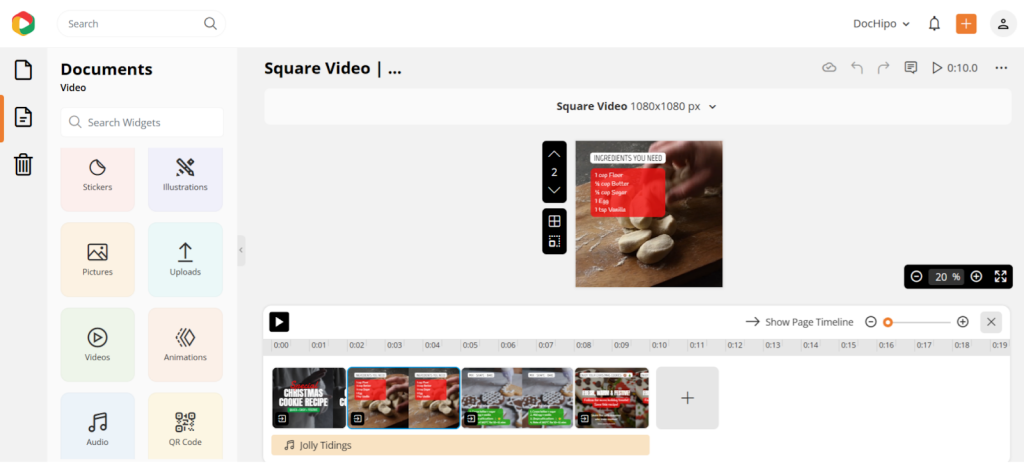
Proposal Maker: Features and Usability
To manage all your marketing and business documents in one place, you need a tool that goes beyond basic proposal templates. An effective solution should offer a complete suite of features, including proposal creation and approval-ready workflows.
While all three tools support proposal building, it’s important to evaluate their additional features and sharing options as well. Let’s dive in and explore them further.
Piktochart
Piktochart offers plenty of proposal templates for a variety of business purposes, such as client reports, marketing, and social media reports. Every layout includes a structured section covering competitor analysis, goals, a roadmap, and an estimated budget.
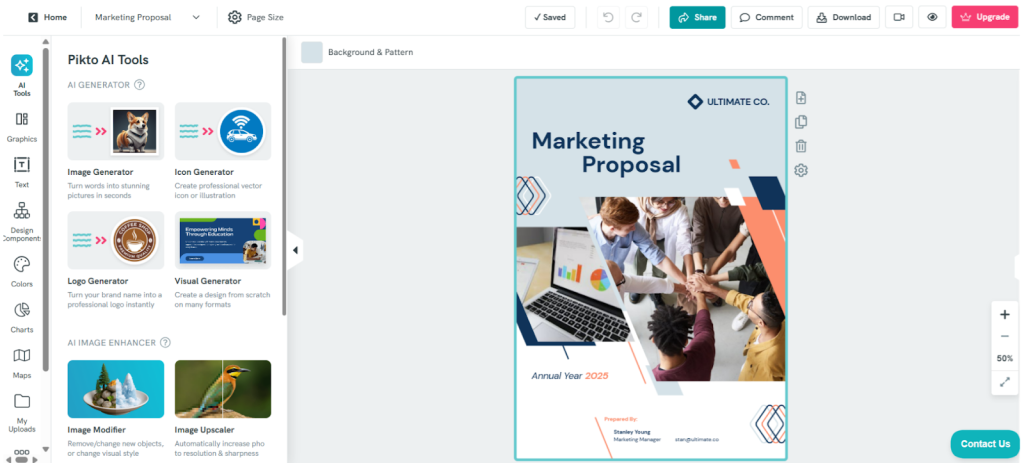
You can customize the text, graphics, and images, and add brand elements to personalize your proposal. Furthermore, you can share the documents with a link or control access with a password.
Canva
Canva also offers professional proposal templates for various industries, but the layouts don’t have a consistent structure. You can find a concise two-page layout as well as long proposals covering all critical deliverables.
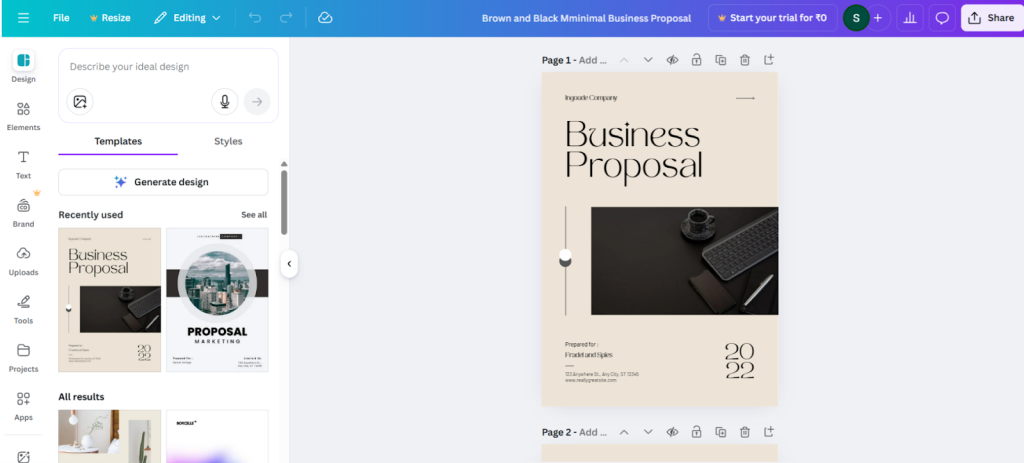
Customizing the proposal is similar to Piktochart, where you can customize the text and graphics. However, Canva does not include any details about what should be included under different sections.
DocHipo
After comparing Piktochart vs Canva, we will explore DocHipo Proposal Maker. Among the three, DocHipo stands out for its website layout, which lets viewers quickly navigate its different sections.
Let’s start with Proposal Templates that cater to industries such as HR, consulting, marketing, and professional services. With a clear structure, you have clear deliverables that include the scope of work, timelines, and a pricing table.
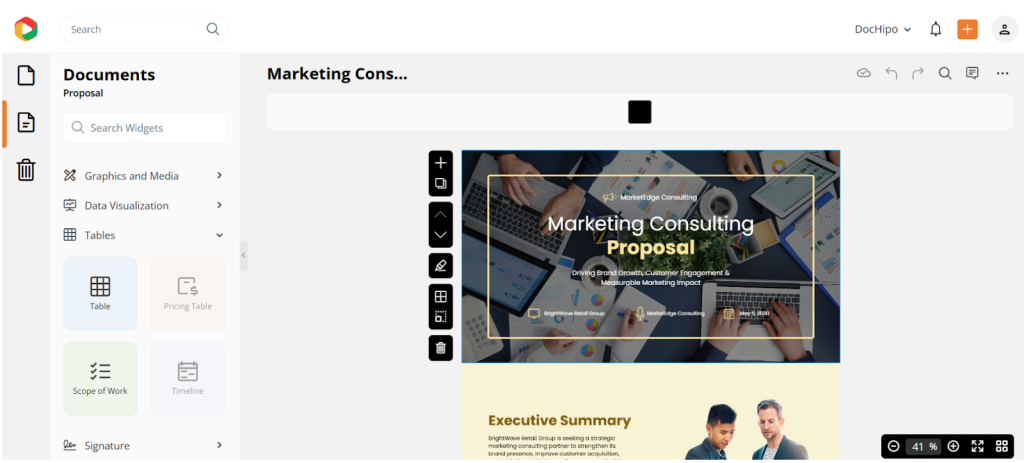
You can add text, images, and graphics of your choice. Plus, with interactive editing, you can also assign currencies, allow editable quantities, define billing frequency, and make items or sections optional.
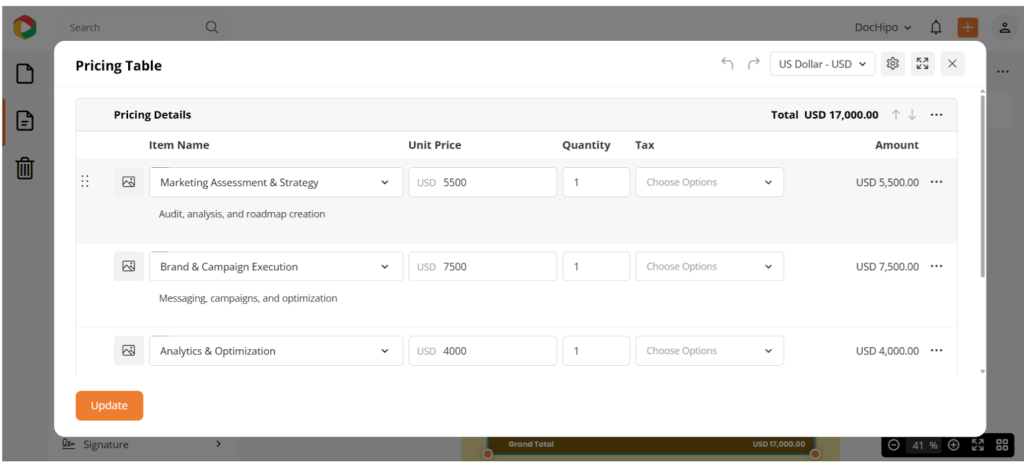
Not just that, DocHipo also helps you publish documents, set an expiration date, and status. The most distinctive feature is the ability to add an e-signature from any device, allowing your clients to close deals without going back and forth. After the approval, the document gets locked to keep it safe and tamper-proof.
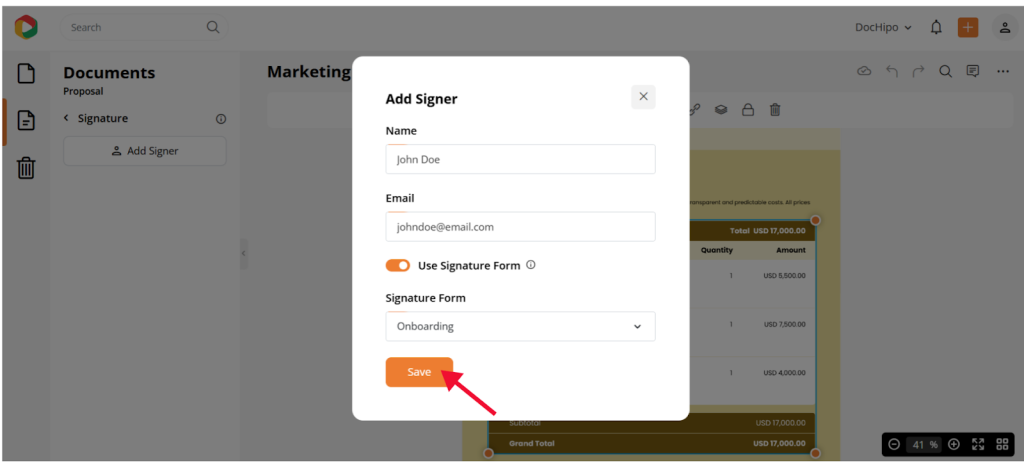
Apps and Integrations for Seamless Workflow
App integrations help the design software make your workflows smoother. So, let’s explore each tool here.
Piktochart
Piktochart’s integrations help you with everyday designing, uploading, and sharing. With Pexels, you can access a vast collection of stock images. On the other hand, the tool integrates with YouTube and Vimeo for seamless video uploading.
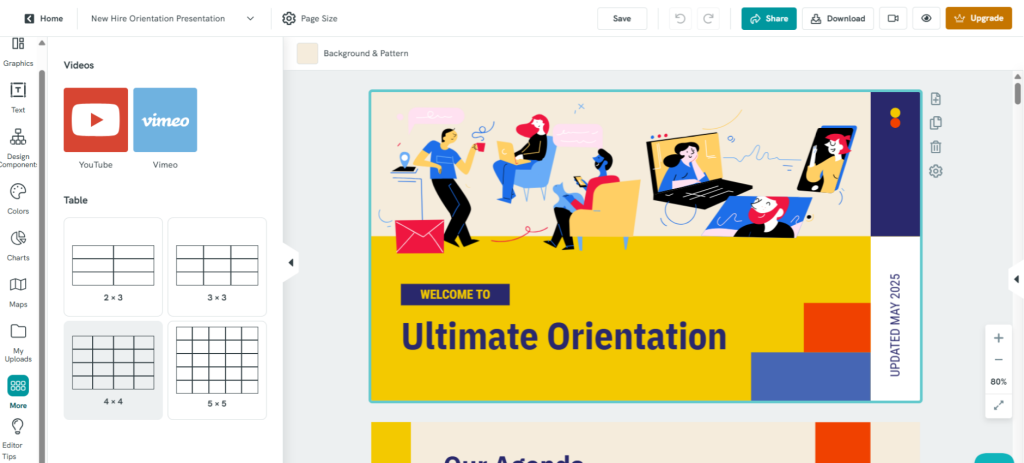
Integrated with Microsoft PowerPoint, Excel, Google Drive, and Google Sheets, Piktochart allows you to access files from various sources. Furthermore, Piktochart Video integration for Zoom lets you import your selected Zoom recordings directly into the video editor.
Canva
Canva integrates with a diverse variety of tools for different purposes. To boost productivity and collaboration, the tool integrates with popular platforms, including Slack, Asana, Google Workspace, and Microsoft Teams.
To enhance designs, Canva allows integration with more than a hundred third-party AI-powered apps, such as Colorize and Image Upscaler. The integrations with Dall-E and OpenAI offer top-notch generative AI capabilities. Furthermore, it features a vast library of stock images, videos, and audio files.
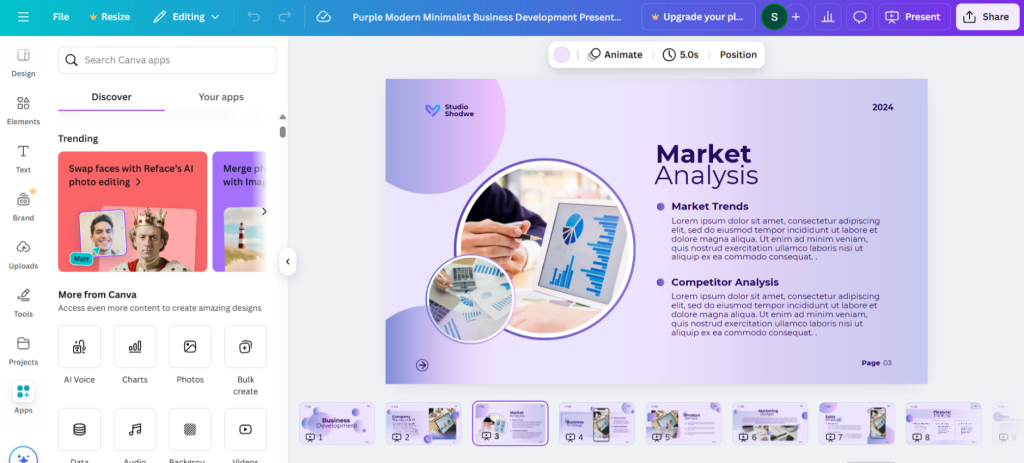
Canva also offers several design apps available to streamline creative workflows, including Mockups, Brandfetch, Typecraft, and Dynamic QR codes.
DocHipo
DocHipo integrations focus on designing, sharing, and collaborating. In contrast with Piktochart, DocHipo integrates with Pexels, Pixabay, and Unsplash to offer you a rich stock photo library. Additionally, you can filter the stock images by color and orientation. Plus, you can access stock videos and YouTube for easy uploads.
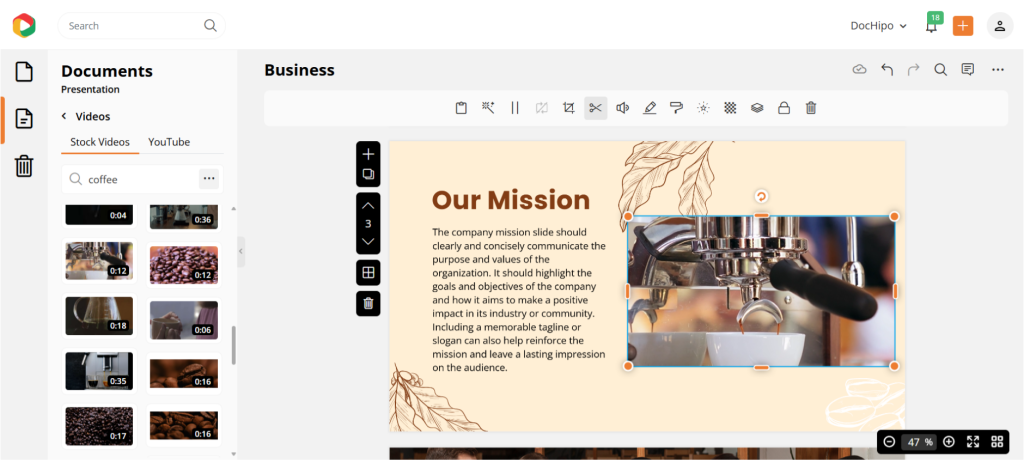
For robust generative AI capabilities, it integrates with OpenAI, Stable Diffusion, and Google Translate. But that’s not all. What makes it stand out is its integration with Typeform and Jotform, enabling you to create feedback-driven designs for sign-ups, surveys, quizzes, and more. Additionally, you can organize your email marketing campaigns by integrating designs with Mailchimp.
Pricing: Piktochart vs Canva vs DocHipo
Pricing is one of the most crucial factors you should consider when using a tool in the long run. Take a look at these to set your budget.
Piktochart
You can access Piktochart for free, with limited credits for PNG downloads and AI design generation. Once you get the hang of the tool, you can access all the capabilities with these paid plans:
- Pro Plan: $14 per month per user, billed annually.
- Business Plan: $24 per month per user, billed annually.
- Enterprise Plan: Custom pricing
Canva
Canva offers a free plan with limited templates and design capabilities. For complete access, you can avail these paid plans:
- Canva Pro: $120 per year per user.
- Canva Teams: $300 per year for a minimum of three users.
- Canva Enterprise: Custom pricing.
DocHipo
DocHipo is quite generous with the free plan, as you can use it as long as you want without any watermark issues in the downloaded documents. However, some assets and features are behind the paywall. Here are the paid plans to access them.
- Pro Plan: $ 7.50/month per user, billed annually. It is ideal for solopreneurs and small teams who need pro tools for advanced document design.
- Pro Unlimited: $225/month for unlimited users. It is best for large teams to design professional documents with advanced tools.
Suitability for Designs and Users: Piktochart vs Canva vs DocHipo
After considering the design capabilities and budgets of Canva vs Piktochart vs DocHipo, you can determine which one is best suited for your needs. It depends on various factors like your design expertise, team size, daily requirements, and budget. Review this comparison chart to assess suitability.
| Tools | Suitability |
| Piktochart | Piktochart is ideal for users who frequently work with complex data and want to transform it into appealing visualizations. It is ideal for marketing professionals, business professionals, educators, students, non-profit organizations, government agencies, and more. |
| Canva | Canva is suitable for a wide range of users and use cases. You can use it for designing and scheduling. It suits non-designers, creators, and social media marketers, and small and large teams. |
| DocHipo | DocHipo is ideal for solopreneurs, businesses, brands, marketers, and teams of all sizes. It helps with on-brand designing with business-focused templates within budget. |
Watch this video to know all about getting started with DocHipo.
Final Verdict for Piktochart vs Canva vs DocHipo
That was a long comparison list for the three tools. We hope that now you can weigh the pros and cons of the design programs. If not, here is the final verdict.
Piktochart is excellent for data visualizations, but the tool can enhance its user experience and accessibility. Its recent developments regarding AI designs and video editing are impressive. However, the app could be more flexible and incorporate AI customizations into the text as well.
As far as Canva is concerned, it’s an all-rounder with a vast array of features. But the recent hike in paid plan prices may not suit your budget. Additionally, many features are designed with customization in mind, particularly for use on social media.
DocHipo strikes the sweet spot among the three tools, allowing you to design with ease while focusing on business-centric designs. Unlike Piktochart, the professional-looking templates capture the attention of your target audience, and the clutter-free interface aims to keep design processes smooth and easy. All of that at an affordable price, keeping in mind your budget. So, sign up today and get started with on-brand designs.
FAQs
What is better than Canva?
There are numerous design tools that are equal to or better than Canva, such as DocHipo, Piktochart, and Kittl, among others.
Which is better Canva or Piktochart?
You can use Canva if you want to design for social media and need advanced photo-enhancing capabilities. Piktochart is handy for creating stunning visuals and internal business communication.
Other than these, you can also explore other tools like DocHipo to create on-brand business-focused designs within minutes.
Is Piktochart free?
Yes, Piktochart is free with limited access to templates, features, and AI capabilities.


